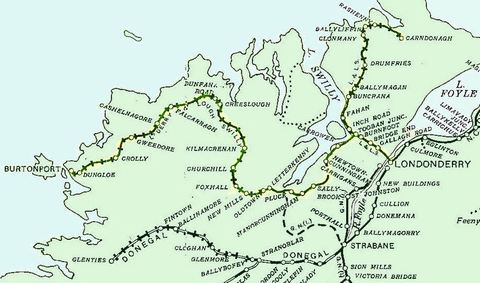Londonderry and Lough Swilly Railway
Probably the most important development in the history of Burtonport was the railway that connected Burtonport with Derry.
Initially planned as the Londonderry and Lough Swilly Railway Company when an application for incorporation was filed in 1852 after spurning the construction of a canal network to connect the two inlets, the company opened its first line, a standard gauge link between Derry and Farland Point on 31 December 1863. A branch line to Buncrana followed in 1864, with much of the Farland Point link being closed in 1866. An extension to Letterkenny was constructed in 1883, and the network was converted to narrow gauge in 1885.
Carndonagh was served by an extension constructed in 1901 and Burtonport in 1903. These two lines were constructed as joint ventures with the British Government, with ownership and liabilities shared between the two parties. During this period the company did not turn a profit, and struggled to meet its debts. The Burtonport line was closed entirely in 1940, with a section temporarily re-opening in 1941 to Gweedore, closing finally in 1947. The remaining Letterkenny services all closing on 8 August 1953.
Despite the company's name (Londonderry and Lough Swilly Railway Company), it does not operate any railway services, its last railway line having closed in July 1953. However, its successor company, the Lough Swilly Bus Company, still operates bus services over much of its old routes between Derry and northern County Donegal, as well as some services in County Londonderry.
Owencarrow Viaduct disaster
Disaster occurred on the night of 30 January 1925 at around 8pm at the Owencarrow Viaduct, Donegal. Winds of up to 120mph derailed carriages of the train off the viaduct causing it to partially collapse. The roof of a carriage was ripped off throwing four people to their deaths. The four killed were: Philip Boyle and his wife Sarah from Arranmore Island, Una Mulligan from Falcarragh and Neil Duggan from Meenbunowen, Creeslough. Five people were seriously injured. The remains of the viaduct can today be seen from the road (N56) which carries on from the Barnes Gap on the road to Creeslough.
Siúlóid An Sean Bhóthar Iarainn—The Old Railway Walk
This beautiful walking trail filled to the brim with spectacular scenery and woodland was originally the route taken by the train which connected Burtonport to Letterkenny between 1903 and 1940.
There are many features of the old railway remaining which you can view along the way including: stations, gatehouses, accommodation crossings—the pillars, cuttings, embankments, a bridge, rusty gates and much much more.
The Burtonport Walks are a series of trails of various lengths, all of which lead the walker along part of the abandoned railway line between Burtonport and Meenbannad in West Donegal, lreland.
The original railway line was built to serve the excellent harbour in Burtonport and as a Government attempt to alleviate the
poverty in North Donegal. lt was a joint venture between the British -Government and the Londonderry- and Lough Swilly Railway.
Opening for traffic in 1903, the line ran through the remote and difficu lt terrain of North Donegal often skirting towns it was meant to serve by miles in an effort to save on the cost of construction . The line was the subject of two enquiries over its safety and operation . The Derry Chamber of Commerce noting "defective construction and inadequate and unsuitable equipment" as a cause of t he lines many ills. Despite this the line managed to survive unti l 1947, the Burtonport - Gweedore section closing earlier in June 1940. The station in Burtonport was demolished early in 2003.
Following a prolonged period of heavy snowfall in the winter of 2009 some of the line on the Burtonport side was cleared to access water mains which needed repairing . The remaining section was later cleared and gradually developed as a walkway with the support of the local community.






